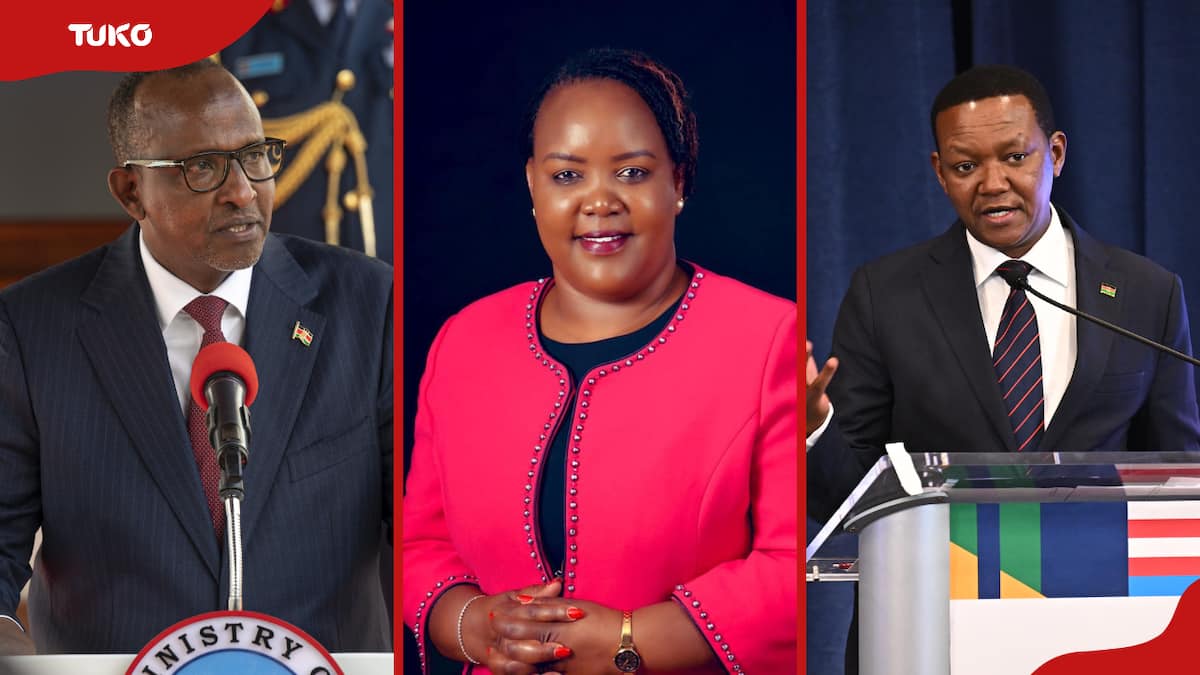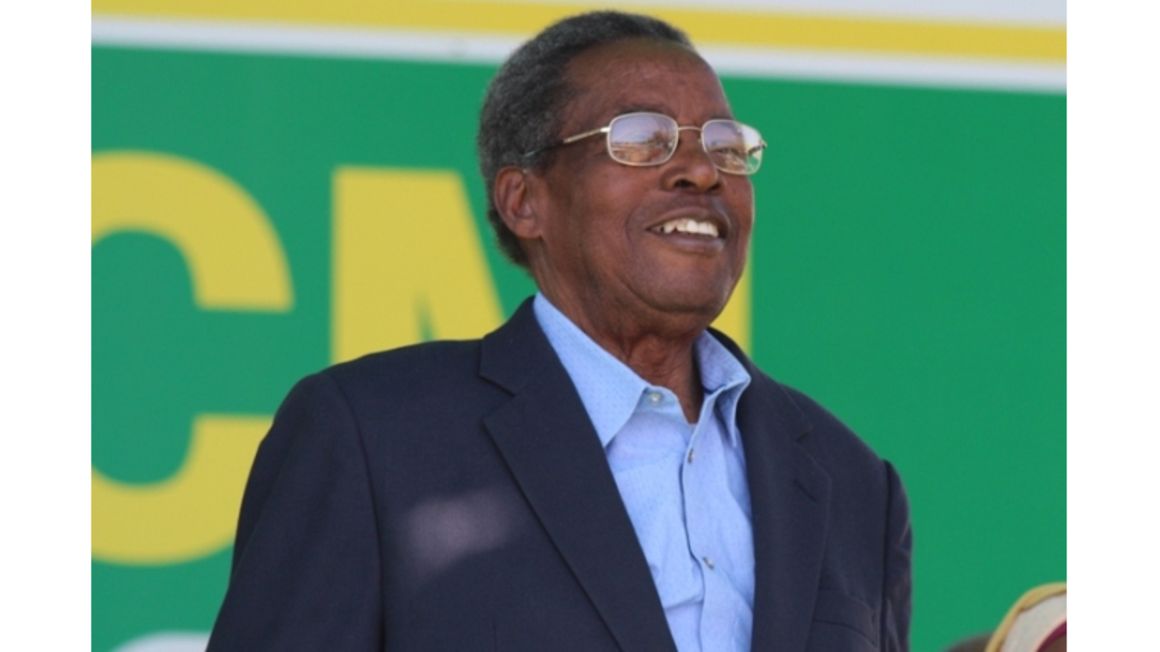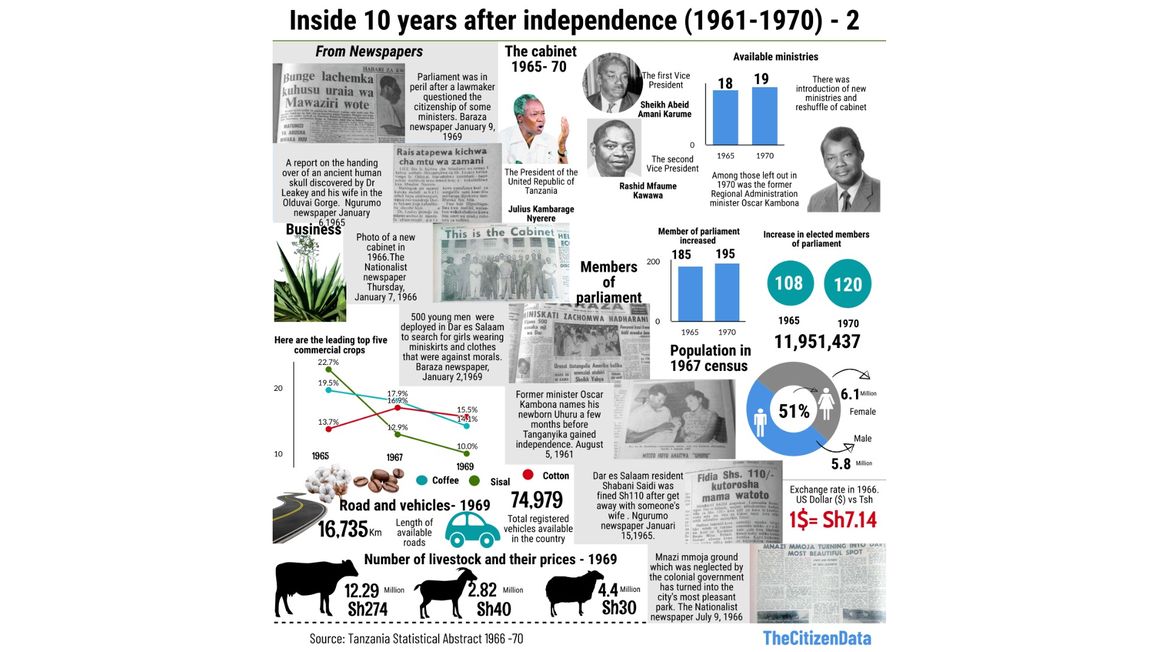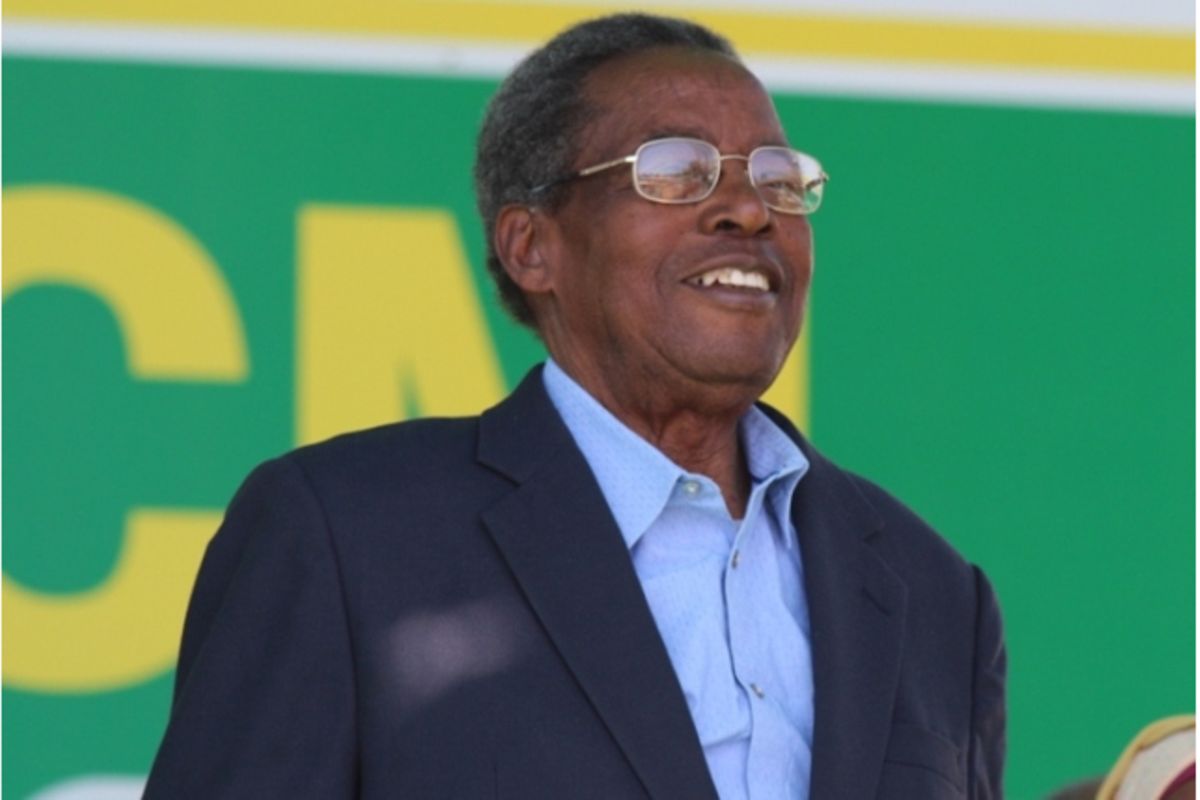Geza Ulole
JF-Expert Member
- Oct 31, 2009
- 59,186
- 79,368
rudi shule ukaitishe refund na usiwaache walio kupa like kwa huu upupu wako! yaani chuki inakufanya hata ushindwe kuhesabu?? ebu angalia hiyo list yako namba 7 na 21 labda hayo ni majina ya wanaume huko dar is slum.List of cabinet secretaries in Kenya and their roles 2021
March 25, 2021
Thursday, March 25, 2021 at 5:24 PM
by Simon Ayub
Structureless democracies topple at any slight distortion, hence the need for proper governance. In Kenya, the President has the support of the Cabinet in running the country's affairs. They include professionals that head different government ministries. These are the pillars of the State; they form a formidable and robust wing of the executive. The Constitution is clear on the appointment, reassignment and dismissal of Cabinet Secretaries in Kenya. The President is mandated to nominate, and upon approval by Parliament, appoint his Cabinet.

Image: twitter.com, @StateHouseKenya
Source: Twitter
The new Constitution implemented massive alterations in government structures and operations. Cabinet members, whom most were referred to as "ministers" are no more. A new, technical term has been adopted – "Cabinet Secretary."
The change that brought Kenyan Cabinet Secretaries resulted in a phase of exercising duties and authorities by the specific occupants. The President, his Deputy, Attorney General and a minimum of fourteen Cabinet Secretaries make the Cabinet in Kenya. These appointees qualify after extensive parliamentary vetting. It is only after approval by the Members of Parliament that they start overseeing ministerial functions.

President Kenyatta among African leaders in Dodoma for Magufuli's Sendoff
Current Cabinet Secretaries in Kenya
Are you familiar with the latest list of Cabinet Secretaries in Kenya? Since they are state appointees, supporting the devolved government functions, they have distinct roles measurable by performance indicators.
1. Dr. Fred O. Matiang’i, EGH – Interior and Coordination of National Government
Chief Administrative Secretary – Hussein Dado
2. Hon. Najib Balala, EGH - Tourism & Wildlife
Chief Administrative Secretary – Joseph Boinnet
3. Mr. James W. Macharia, EGH - Transport, Infrastructure, Housing, Urban Development &
Public Works
Chief Administrative Secretary – Chris Obure and Wavinya Ndeti
4. Amb. Raychelle A. Omamo Foreign Affairs
Chief Administrative Secretary – Hon Ababu Namwamba
5. Amb. Amina C. Mohamed, EGH, CAV - Sports, Culture & Heritage
Chief Administrative Secretary – Hassan Noor Hassan
6. Mr. Adan A. Mohamed, EGH - East African Community & Regional Development
Chief Administrative Secretary – Ken Obura
EACC arrests ex-REA boss, 3 others over KSh 100m solar power tender scam
7. Mrs. Sicily K. Kariuki, EGH - Water & Sanitation and Irrigation
Chief Administrative Secretary – Andrew Tuimur
8. Hon. Eugene Wamalwa, EGH – Devolution
Chief Administrative Secretary – Abdul Bahari
9. Hon. Charles Keter, EGH – Energy
Chief Administrative Secretary – Simon Kapchapin
10. Mr. Joe Mucheru, EGH - Information, Communication, Technology (ICT), Youth & Innovation
Chief Administrative Secretary – Maureen Magoma Mbaka and Nadia Ahmed Abdalla
11. Hon. Peter Munya, EGH - Agriculture, Livestock, Fisheries & Cooperatives
Chief Administrative Secretary – Linah Chebii and Anne Martha Muakami Nyaga
12. Prof. Margaret Kobia, EGH - Public Service & Gender
Chief Administrative Secretary – Rachel Shebesh
13. Hon. John K. Munyes, EGH Mining and Petroleum
Chief Administrative Secretary – John Mosonik
14. Amb. (Dr.) Monica K. Juma, EGH - Defense
Chief Administrative Secretary – Peter Ondonyo
15. Mr. Simon K. Chelugui, EGH - Labour & Social Services
Chief Administrative Secretary – Patrick Ole Ntutu
Uhuru urges NASA principals to stop fighting, unite against 'common enemy'
16. Mr. Keriako Tobiko, EGH - Environment & Forestry
Chief Administrative Secretary – Mohammed Elmi
17. Ms. Farida C. Karoney, EGH - Lands & Physical Planning
Chief Administrative Secretary – Gideon Mungaro
18. Hon. (Amb.) Ukur K. Yatani, EGH - National Treasury and Planning
Chief Administrative Secretary – Nelson Gaichuhie
19. Prof. George A.O. Magoha, EGH – Education
Chief Administrative Secretary - Zachariah Kinuthia Mugure and Mumina Bonaya
20. Hon. Mutahi Kagwe - Health
Chief Administrative Secretary – Rashid A. Amana and Mercy Mukui Mwangangi
21. Ms. Betty Maina - Industrialization, Trade & Enterprise Development
Chief Administrative Secretary – Lawrence Karanja
The above list of new Cabinet Secretaries in Kenya has undergone public vetting by Parliament before swearing-in. They have different levels of experience in their professions. This team is a constitutional gift to Kenya. Various changes have taken place in the different governmental sectors due to their efforts.

List of all Cabinet Secretaries in Kenya and their profiles in 2024
The Cabinet Secretaries in Kenya are responsible for the day-to-day running of the ministries in the Kenyan government. Find out who the current CS are.www.tuko.co.ke
MY TAKE
Kenya has 5 women ministers vs 7 for Tanzania
Mitumba iliyojichokea huko nje inatumika Kenya dah Global warming haituachi aisee!Do I really give a fu-ck about Kiswahili?The good thing is that my point is at home.
More of Kenyan buses
View attachment 1938507
Hiyo ndio Bus Station yenu dahSome fools will say that they travel a lot while in real sense Kenyans travel more than them
View attachment 1938525
View attachment 1938526

Hizo berths 22 ni za urefu gani maana hawakawii kuita sehemu ya mitumbwi kushushia samaki berth hawa.Point of correction, I totally agree Mombasa port is bigger than Dar, but Dar port currently has 11 berths and not less than that




Cha mtoto bado!🙂This is dreamline. Show me any bus that can have interior like this.
View attachment 1938404
View attachment 1938405
View attachment 1938406
Kenya bado Sana 🙂When it comes to luxurious buses, we are ahead of you.
View attachment 1938440
View attachment 1938441
Nimeishi Nairobi zaidi ya 10 years. Ni kweli Nairobi wametuzidi kimiundo mbinu ya barabara. Network ya barabara ya mjini iko very beautiful and smart.Hizi thread zinanipaga raha sana kusoma.. Kama mbongo nadhani facts ziwe facts.. Nairobi imetuzidi sana kimiundombinu haswa barabara na reli.. Watanzania waliofika ama kuishi Nairobi watakubaliana nami kwa hili. Cha msingi ni kuwa kwa sasa Dar nayo inajitahidi kukechi up ingawa naona kwa kiasi kikubwa ni majengo tu yanapanda lakini barabara na miundombinu mingine kama ya barabara (including public transport.. And yes najua kuhusu BRT), intaneti ya mwendo kasi N.K.vinasua sua sana..
Simba? Bora ungesema modern coast,mash poa na dreamline ambazo uki minus Kenya mnabaki na scrapers 🙂Mabasi zetu are better than the ones in Tanzania. Again Kenyans travel more than you witches.
View attachment 1938436
View attachment 1938437
True to your comments.Server za JF mnazijaza aisee.....same pictures over and over
Anyways, my contribution here is this
1) Dar es Salaam and Nairobi are both large cities by African standards, with Dar leading in terms of geographical size and population but Nairobi still ahead economically - that is in Gross Metropolitan Product (GMP) terms
2) Dar es Salaam will have crossed the 10 million residents mark by 2030, joining Kinshasa, Cairo, Lagos, Luanda and Johannesburg to be the only African megacities by then
3) Dar es Salaam will lift the most people out of poverty of any other African city.
4) Proper urban planning will be critical for both Nairobi and Dar es Salaam particularly hapo kwenye urban infrastructure. I have to say Nairobi is kind of ahead of Dar es Salaam in this; the roads there are spacious and not to mention the flyovers and the expressways. Dar es Salaam needs to catchup fast kwenye barabara focus isiwe sana kwenye majengo tu.
5) We need to stop focusing much on our cities and more on our rural population, which comprises over 70% of our populations. I hate to say this but Magufuli's government is not pro-poor as he famously claims it to be!
🤣🤣🤣🤣🤣🤣🤣umemshtukia huyo katuni
Sasa ni muda muafaka tutumie GDP yetu kujenga wenyewe hii Expressway kuliko kudharaulika mbele ya wenye hela duniani.The US firm contracted to build the Sh300 billion Nairobi-Mombasa Expressway has rejected Kenya’s offer.
PBO on Tuesday said American contractor Bechtel has settled on a model where the State pays it for building the road instead of recovering its money through user fees.
The US firm contracted to build the Sh300 billion Nairobi-Mombasa Expressway has rejected Kenya’s offer to have it construct the road and recover its costs from charging motorists toll fees.
The Parliamentary Budget Office (PBO) on Tuesday said American contractor Bechtel has settled on a model where the State pays it for building the road instead of recovering its money through user fees.
This will force the government to borrow the billions of shillings, jerking public debt whose rapid growth has triggered warnings and throwing the road construction into limbo.
Motorists were expected pay toll charges for the luxury of cruising on the route which is currently characterised by heavy congestion and slow speeds.
The budget office cited a study by Inter-America Development Bank showed a road is likely to be a viable candidate for construction through the toll model if it has a flow exceeding 5,000 vehicles per day unless the government offers a substantial subsidy to the contractor.
“This limits the number of roads that can be undertaken by the model in Kenya to a few sections of the main transport corridors. Along the A8 (Malaba – Eldoret – Nakuru – Nairobi – Voi – Mombasa) road, the Nairobi Expressway has so far proved to be a viable section for tolling while the Mombasa – Nairobi Expressway has proved difficult,” PBO said.
“The contractor has indicated that the country will get better value for money if the road is constructed under an EPC (Engineering, Procurement and Construction) model rather than a toll model.”
Bechtel argues that the alternative public-private partnerships (PPP) model where the contractor sources for funds would cost five times more at $15 billion (Sh1.5 trillion) and take much longer to complete.
The plan to build the Nairobi-Mombasa Expressway dates back to the July 2015, when then US President Barack Obama signed a memoramdum of understanding with the Kenyan government.
The US government nominated construction giant Bechtel Corporation to be considered for the project.
The new dual carriageway was set to have two lanes on either side and run parallel to the current Nairobi-Mombasa Road.
The project contract was signed in August 2017 and was single-sourced to the American firm, keeping with the tradition of state-to-state funding deals that favour companies from the financing country.
The toll model has been hailed as a solution to the road financing problem since it takes the pressure off a country to accumulate public debt.
Many countries, including the Canada, France, UK, India, South Africa and Nigeria, have adopted the toll model to fund their road infrastructure.
Toll fees were introduced in Kenya in the late 1980s but were scrapped in the mid-1990s in favour of the roads maintenance levy currently charged at Sh18 per litre of petrol and diesel.
Kenya is seeking to maintain the pace of spending on new infrastructure with funding from private backers while reducing borrowings and budget deficit.
The current Sh7.8 trillion public debt accounts for 72 percent of the GDP and is above the threshold set to measure sustainability.
The government has approved construction of Nairobi Expressway by China Road and Bridge Corporation (CRBC) granting the firm a concession to operate the road and recover funds by charging motorists toll fees for 30 years before ceding it to the State.
The project is ongoing and is expected to be completed by December, 2021 at an estimated cost of Sh67 billion.
Roads targeted for tolling include Nakuru Highway, Mombasa Road, Thika Superhighway and Nairobi’s Southern Bypass.
The PBO has, however, raised concerns that toll roads may lead to civil unrest.
The Chinese contractor has kicked off recruitment of attendants to collect toll fees as the pay-for-use project nears completion.
“The Nairobi Expressway project has also not won full support of the public since the project is shrouded [in secrecy], with lack of proper and comprehensive information disclosure and other ambiguities especially on assumptions behind the 30 years’ period given to the investor and the risk mitigation measures if the assumptions fail to hold,” the PBO said.
There are also concerns that tolls will be a double tax on many motorists who are currently paying for road maintenance through the fuel levy.
The budget office cited the case of Nigeria where the tolling collection was cancelled on the Lekki Toll Road after community riots against paying of tolls.
In Kenya, a proposal to introduce tolling in 2016 on the Nairobi Southern Bypass sparked public outcry.
View attachment 1938662
Hizi stand zao zinatia kinyaa sana.
haujazungumzia transiportation system,e.g vituo vituo vya daladalaNimeishi Nairobi zaidi ya 10 years. Ni kweli Nairobi wametuzidi kimiundo mbinu ya barabara. Network ya barabara ya mjini iko very beautiful and smart.
Dsm, well tunakomaa. Hatuko vibaya. Kuna sekta tupo vizuri sana. Reli ya SGR ikimalizika nadhani tutaweza kuvimba kidogo. Network ya UDART nayo ni interesting hasa hizi njia mpya zinazofunguliwa.
Kwa majengo we have no doubt about dsm. well, I can say tuko 50 50 na Nrb. Thanks to NSSF wanaojenga migorofa mirefu na yenye ubora flani.
Social amenities kama vile tuko 50 50. Japo waTz hatujui kujivunia vyetu. MNH na facilities zinazoanzishwa pale ni kipengele. Nairobi pia they have incredible hospitals.
Malls za DSM zipo classic japo business ya supermarkets dsm haikui kulingana na culture yetu waTz. Ukweli ni kwamba Nairobi wametuzidi kwa huduma ya supermarkets. We can brag with malls around ila bado hatuwezi compare na Nairobi.
Hatuna game reserves ndani ya jiji la Dsm kama Nairobi. Advantage yetu ni coastline ambayo inatufanya tuvimbe kidogo na coral and marine life along. Sure, Kuna kigamboni connectivity ya ferry. Nairobi hawana.
Nairobi kuna expensive places kama Lavington, Kileleshwa, Langata n.k hata DSM zipo. Masaki Oyestrbay na Avic Town ni places za kujivunia.
Just in t kama nimesahau au kuzidisha kitu. I stand to be corrected.
Mkuu ukilinganisha Vituo vya daladala, Nairobi wanatumia namba kutambua routes zao. Mfano route 134. DSM hata sijui tunatumia nini ila zaidi rangi ambazo pia zipo Nrb na barabara mfano Pugu road.haujazungumzia transiportation system,e.g vituo vituo vya daladala